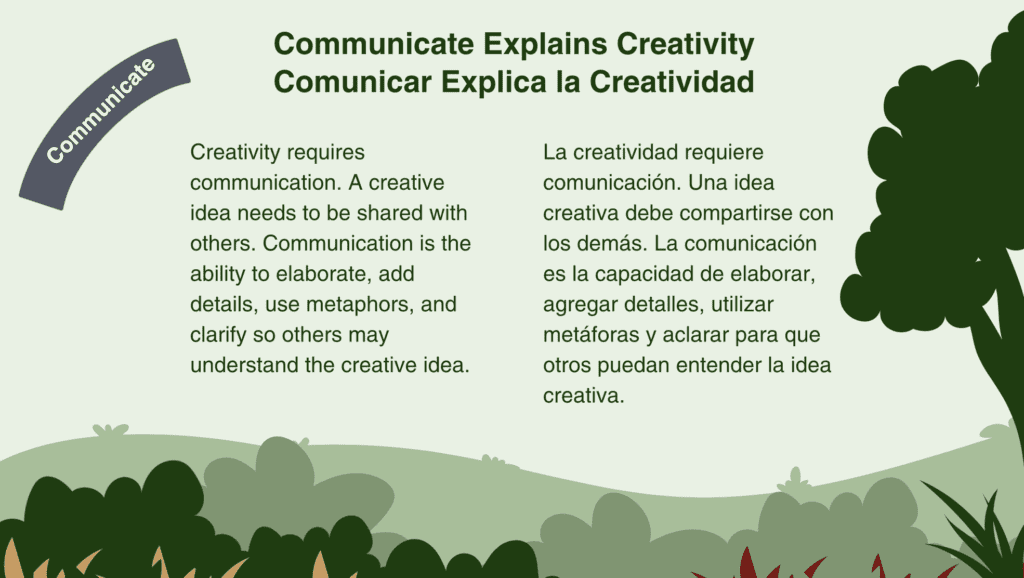Communicate for Creativity
Communication is one of the Create 8 skills essential for boosting creativity. Whether you’re trying to explain an idea, share a better solution, or discuss change, developing the skill of communication is invaluable.

Most originally generated ideas cannot reach their full potential if not communicated to others. Ideas that remain confined to the mind are only accessible to one person. Creativity usually requires sharing those ideas with others. Therefore, practicing the communication of your originally generated ideas is essential.
Effective communication for creativity involves the ability to elaborate, add details, use metaphors, and clarify so others can understand the new creation. This applies not only to written or spoken communication but also to visual communication through pictures, charts, graphs, or digital images.
The old cliché, “a picture is worth a thousand words,” holds true in the human creative process. Visual representations are powerful tools for communication. Feeling confident in your ability to utilize these communication habits will enhance your creativity skillset
Practicing Communicate: Doodle the Problem Away
Doodling, or improvising sketches, is often seen as daydreaming or a waste of time. However, when it comes to creative thinking, this couldn’t be further from the truth. Human brains are wired to process visual images, and to some extent, we are all visual learners. Representing ideas with images allows your brain to form new connections. Thus, turning your ideas into pictures can be highly beneficial for creative thinking.
To practice communicating through drawing, gather some art supplies, including a sketchbook and various drawing materials. Allow yourself to feel like a kid again by using crayons, markers, pens, or any other appealing art supplies. Next, bring a problem to mind that you would like to solve. Use the following prompts to represent the problem through pictures. Just draw, do not judge yourself. No one needs to see your artwork. It is the process that is important, not the product.
What shapes could represent this problem?
What symbols could represent this problem?
What type of lines represent this problem?
What symbols represent how I would feel if the problem was solved?
What colors represent this problem?
What colors could represent the solution to this problem?
Do not expect an immediate solution to the problem, although that may occur. Instead, allow the art to sink in for a few days
Meditation for Communicate
This meditation is a body scan. Close your eyes or lower your gaze. Notice your breathing—inhale and exhale.
Now, start to notice each area of your body. Move your attention to your feet. Notice your feet, your toes, your ankles. Send the breath to your feet.
Next, move your attention to your shins. Notice your shins and calves. Breathe into your lower legs. Gradually, move your attention higher.
When focused on each body location, you may notice sensations, buzzing, tingling, pressure, tightness, or temperature. Or you may notice no sensation. Both are just fine. There are no right answers. Just notice what is happening now. Do not judge what you feel; just feel and notice.
Now, move your attention to your thighs. Notice your thighs. Breathe into your thighs. Continue this process, moving your attention higher, through your abdomen, chest, arms, neck, and finally to the top of your head.
Pause and remind yourself to practice being curious and open to what you are noticing about your body. Notice and then allow the feeling to release before moving on to the next area of your body.
At the end of exploring the body, gently open your eyes. Take one last breath and notice how you feel.
Living Creatively
Communicate is a vital skill for enhancing creativity. Effective communication allows ideas to reach their full potential by sharing and elaborating them with others, utilizing not only verbal and written methods but also visual tools like pictures and graphs. Visual representations can significantly aid in the creative process, as they help form new connections in the brain.
A practical exercise suggested is doodling to solve problems, emphasizing that drawing can help represent and process ideas visually. This involves using various art supplies to sketch symbolic representations of problems and their potential solutions without self-criticism.
Additionally, communicate benefits from meditation exercises to enhance mindfulness and openness. This involves focusing attention sequentially on different body parts, noticing sensations without judgment, and promoting a state of curiosity and awareness. This practice can aid in fostering a calm and receptive mindset, beneficial for creative thinking.